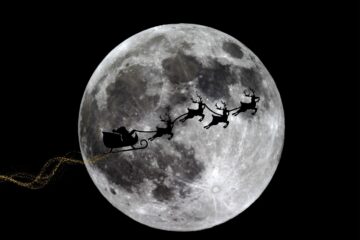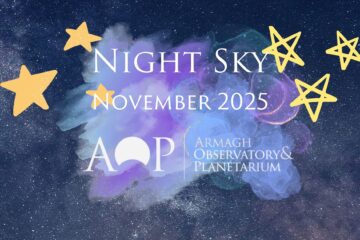This July will be a very astronomically eventful month – full of eclipses, bright planets, meteor showers and bright satellite passes. If the weather permits, we will have the opportunity to witness a lot of interesting events in the night sky.
The Solar System
All five bright planets will be visible in the evenings/mornings of July. On 12th July Mercury will be at its Greatest Eastern Elongation.
Mercury is the closest planet to the Sun. This is why for observers here on Earth, Mercury never strays far from the Sun. This makes the planet very hard to spot low in the evening sky or in the minutes before sunrise. For the month of July 2018 it will be visible close to the North-West horizon in the minutes after sunset. This month Mercury will reach its Greatest Eastern Elongation of 26.4 degrees from the Sun. This means that Mercury will be at its furthest point from the Sun as seen on our evening sky. The small planet will be visible in the low North-West horizon and will set at 22:50pm or about 1 hour after sunset. If you want to observe it, find a place with clear North-West horizon and look for the bright dot in the minutes after sunset. If you want to observe Mercury with binoculars, do not use them before the Sun has completely set! Looking at the Sun with binoculars or a telescope can seriously damage your sight!
15th July – Conjunction of Venus and the crescent Moon
Venus can be seen in the western sky, just after sunset. It is hard to miss it, as it is the brightest object on the sky after the Sun and the Moon. Venus will be setting about one and a half hours after sunset. On the evening of the 15th July/early hours of the 16th, Venus will be in conjunction with the very thin crescent Moon, separated by less than 1 lunar diameter (at 04:30am on 16th July). This will not be visible for the observers in Northern Ireland, for them the Moon and Venus will set with about 4 degrees separation, with Mercury just a few degrees to the West.
27th July – Mars at Opposition.
The red planet will be at its closest approach to Earth and its face will be fully illuminated by the Sun. It will be brighter than any other time of the year and will be visible all night long. This is the best time to view and photograph Mars. A medium-sized telescope will allow you to see some of the details on the planet’s orange surface. Currently there is a big dust storm on Mars, obscuring most of the surface features and making the planet look extra red.
For the days around the 27th July, Mars will be rising shortly after sunset, or around 10:15pm. It will reach maximum altitude of about 10 degrees above the horizon (at around 2am), so if you want to observe it, you will need to find a place with clear East and South horizon. On the night of the closest approach, the full Moon will be about 7 degrees away from Mars, making it slightly harder to observe. However, on the 30-31 July and the first days of August, the waning moon will be rising later in the night and will allow a few hours of moonless observations.
20th July – Conjunction of Jupiter and the Moon.
In July Jupiter can be seen from sunset (when it will be in the South-Western sky) to 1:30am. When observed with binoculars or a small telescope, you can see the four Galilean moons and details on Jupiter’s surface such as the Great Red Spot and the darker bands on the planet. On the night of 20th /21st July, Jupiter will be in conjunction with the Moon.
25th July – Conjunction of Saturn and the Moon.
For the month of July Saturn will be rising at sunset, so it will be visible the whole night. The ringed planet will be in the constellation of Sagittarius, appearing in front of the band of the Milky way, making it an attractive target for astrophotography. In the morning hours of the 25th July, Saturn will be in conjunction with the Moon.
27th July – total Lunar eclipse
The month of eclipses
Solar and Lunar eclipses occur when the Moon is between us and the Sun, casting a shadow on the Earth, and when the Moon passes through the shadow the Earth casts in space.
In the next few weeks there will be three eclipses visible from our planet – a partial Solar eclipse on the 13th July, a total Lunar eclipse on the 27th July, and another partial Solar eclipse on the 11th August. Normally eclipses come in pairs, a solar and a lunar one 14 days apart, but on rare occasions like this, there are three in the same Lunar month, or from New Moon to New Moon.
For all observers in Northern Ireland, only the lunar eclipse on the 27th July will be visible. This will be the longest eclipse of the 21st century with a totality phase duration of 113 minutes. Beginning to end, the eclipse will last for 6 hours and 14 minutes.
For Armagh the eclipsed Moon will be rising at 21:28 BST, just a few minutes before sunset. The full eclipse will end at 22:13 BST with the Moon just 4 degrees above the horizon. The Moon will fully come out of the dark shadow (umbra) of the Earth at 23:19 BST, and from the brighter penumbra at 00:28 BST. If weather permits, the best place to observe this eclipse will be somewhere with a clear South-East horizon.
Keep an eye out on our website for any events we might be hosting around this time and for more information on visibility and how the eclipse will appear for observers in Armagh, visit: timeanddate.com
27th July – more than just a Lunar eclipse
The night of the 27th July will be extra special. Not only will we see a total eclipse of the Moon, which will be the longest eclipse for the 21st century, but it is also the exact date Mars will be closest to us for the last 15 years. Mars and the eclipsed Moon will be in conjunction only 6 or so degrees apart, making the view even more spectacular.
28th /29th July – Delta Aquarids Meteor Shower.
The Delta Aquarids meteor shower can produce up to 20-25 meteors per hour at its peak. The meteors will appear to be coming out of the constellation Aquarius The Water Carrier. They are caused by dust and small particles left behind by comets colelctively known as the Marsden and Kracht groups that may be related to comet 141P/Macholtz. Whenever one of these small particles encounters the Earth, it burns in the upper layers of our atmosphere and the light coming from it is called a meteor. The Delta Aquarids can be seen from 12th July to the 23rd August. This year’s peak falls on the night of 28th/29th July just after midnight. Around this time the waxing gibbous Moon (1 day after Full Moon) will be rising and outshining the fainter meteors, making this shower hard to observe.
The International Space Station (ISS) returns!
After more than a month of no visible passes, the The International Space Station (ISS) returns. For the period from 07 July 2018 to 06 August 2018, the ISS will be visible from Northern Ireland in the evenings and early mornings, making a few bright passes above us each night. The ISS always moves from West to East, opposite all planets, stars, the Moon and the Sun (which is also a star!), and it outshines all stars on the sky. It is the biggest man-made satellite, measuring more than 100 by 70 meters. It orbits the Earth once every 92.5 minutes, making it possible for the astronauts on board to see 15 sunrises and sunsets a day!
For more information on when the ISS will be visible from your location, visit heavens-above.com and simply put in your coordinates. (The coordinates for the Armagh Planetarium are: Latitude: 54.3521, Longitude: -6.6485)
Occasionally the path of the ISS in the sky crosses the disks of the Sun or the Moon, and this is called an ISS transit. It is rare to see one of these events, but well worth it. As seen from the Armagh Observatory and Planetarium, the next ISS transit in front of the Moon will be on Saturday 21st July at 00:19:54 BST. These transits last only a second or two, and if you wish to photograph them you have to be prepared well in advance and use fast shutter speeds. You can miss an ISS transit in the blink of an eye.
More information on when the ISS will cross the Sun or the Moon from your location you can find here: transit-finder.com.
Iridium flares
The Iridium satellites are a group of 95 communication satellites orbiting the Earth since 1997. Thanks to these, we can make phone calls to every place on Earth. For the last 21 years people have been seeing bright flashes (called flares) caused by the reflection of sunlight from the satellites’ panels. The effect is exactly the same as catching sunlight with a small mirror. Iridium flares occur in the hours after sunset and before sunrise, and can often outshine all stars and planets on the night sky. In the summer months the nights are very short and the Iridium flares can be seen from dusk to dawn. They make wonderful addition to any photos of the night sky.
Information on bright flares in your area you can visit heavens-above.com and don’t forget to put in your coordinates.
Article written by: Yanina Metodiva







0 Comments